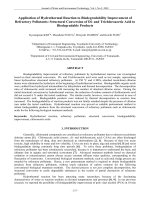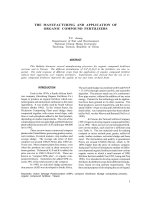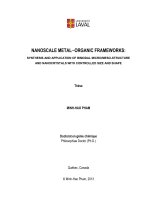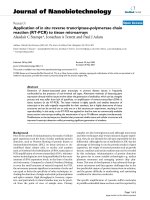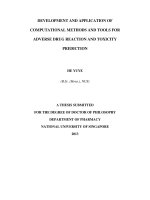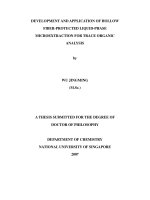Strategic Application of Named Reaction Organic Symthesis
Bạn đang xem bản rút gọn của tài liệu. Xem và tải ngay bản đầy đủ của tài liệu tại đây (18.85 MB, 810 trang )
TABLE OF CONTENTS
SEARCH TEXT
Strategic Applications
of Named Reactions in
Organic Synthesis
pr
o
vi
d
ed
by
w
jsw
ift
&
Y
iL
ua
n
MAIN
MENU
TABLE OF CONTENTS
SEARCH TEXT
ii
www.pdfgrip.com
TABLE OF CONTENTS
SEARCH TEXT
Strategic Applications
of Named Reactions in
Organic Synthesis
Background and
Detailed Mechanisms
by
László Kürti and Barbara Czakó
UNIVERSITY OF PENNSYLVANIA
250 Named Reactions
AMSTERDAM • BOSTON • HEIDELBERG • LONDON • NEW YORK • OXFORD • PARIS
SAN DIEGO • SAN FRANCISCO • SINGAPORE • SYDNEY • TOKYO
iii
www.pdfgrip.com
TABLE OF CONTENTS
SEARCH TEXT
Senior Publishing Editor Jeremy Hayhurst
Project Manager Carl M. Soares
Editorial Assistant Desiree Marr
Marketing Manager Linda Beattie
Cover Printer RR Donnelley
Interior Printer RR Donnelley
Elsevier Academic Press
30 Corporate Drive, Suite 400, Burlington, MA 01803, USA
525 B Street, Suite 1900, San Diego, California 92101-4495, USA
84 Theobald's Road, London WC1X 8RR, UK
This book is printed on acid-free paper.
Copyright © 2005, Elsevier Inc. All rights reserved.
No part of this publication may be reproduced or transmitted in any form or by any
means, electronic or mechanical, including photocopy, recording, or any information
storage and retrieval system, without permission in writing from the publisher.
Permissions may be sought directly from Elsevier’s Science & Technology Rights Department in Oxford,
UK: phone: (+44) 1865 843830, fax: (+44) 1865 853333, e-mail: You may
also complete your request on-line via the Elsevier homepage (), by selecting
“Customer Support” and then “Obtaining Permissions.”
Library of Congress Cataloging-in-Publication Data
Application Submitted
British Library Cataloguing in Publication Data
A catalogue record for this book is available from the British Library
ISBN: 0-12-429785-4
For all information on all Elsevier Academic Press Publications
visit our Web site at www.books.elsevier.com
Printed in the United States of America
05 06 07 08 09 10 9 8 7
6
5
4
3 2 1
iv
www.pdfgrip.com
TABLE OF CONTENTS
SEARCH TEXT
This book is dedicated to
Professor Madeleine M. Joullié
for her lifelong commitment
to mentoring graduate students
v
www.pdfgrip.com
TABLE OF CONTENTS
SEARCH TEXT
vi
www.pdfgrip.com
TABLE OF CONTENTS
SEARCH TEXT
ABOUT THE AUTHORS
Barbara Czakó was born and raised in Hungary. She
received her Diploma from Lajos Kossuth University in
Debrecen, Hungary (now University of Debrecen). She
obtained her Master of Science degree at University of
Missouri-Columbia. Currently she is pursuing her Ph.D.
degree
in
synthetic
organic
chemistry
under
the
supervision of Professor Gary A. Molander at the
University of Pennsylvania.
László Kürti was born and raised in Hungary. He
received his Diploma from Lajos Kossuth University in
Debrecen, Hungary (now University of Debrecen). He
obtained his Master of Science degree at University of
Missouri-Columbia. Currently he is pursuing his Ph.D.
degree
in
synthetic
organic
chemistry
under
the
supervision of Professor Amos B. Smith III at the
University of Pennsylvania.
vii
www.pdfgrip.com
TABLE OF CONTENTS
SEARCH TEXT
ACKNOWLEDGEMENTS
The road that led to the completion of this book was difficult, however, we enjoyed the support of
many wonderful people who guided and helped us along the way. The most influential person was
Professor Madeleine M. Joullié whose insight, honest criticism and invaluable suggestions helped to
mold the manuscript into its current form.
When we completed half of the manuscript in early 2004, Professor Amos B. Smith III was
teaching his synthesis class "Strategies and Tactics in Organic Synthesis" and adopted the manuscript.
We would like to thank him for his support and encouragement. We also thank the students in his class
for their useful observations that aided the design of a number of difficult schemes.
Our thanks also go to Professor Gary A. Molander for his valuable remarks regarding the
organometallic reactions. He had several excellent suggestions on which named reactions to include.
Earlier this year our publisher, Academic Press/Elsevier Science, sent the manuscript to a
number of research groups in the US as well as in the UK. The thorough review conducted by the
professors and in some cases also by volunteer graduate students is greatly appreciated.
They are (in alphabetical order):
Professor Donald H. Aue (University of California
Santa Barbara)
Professor Ian Fleming (University of Cambridge,
UK)
Professor Rainer Glaser (University of MissouriColumbia)
Professor Michael Harmata (University of MissouriColumbia)
Professor Robert A. W. Johnstone (University of
Liverpool, UK)
Professor Erik J. Sorensen (Princeton University)
Professor P. A. Wender (Stanford University) and
two of his graduate students Cindy Kan and John
Kowalski
Professor Peter Wipf (University of Pittsburgh)
We would like to express our gratitude to the following friends/colleagues who have carefully read
multiple versions of the manuscript and we thank them for the excellent remarks and helpful discussions.
They were instrumental in making the manuscript as accurate and error free as possible:
James P. Carey (Merck Research Laboratories)
Akin H. Davulcu (Bristol-Myers Squibb/University of
Pennsylvania)
Dr. Mehmet Kahraman (Kalypsys, Inc.)
Justin Ragains (University of Pennsylvania)
Thomas Razler (University of Pennsylvania)
There were several other friends/colleagues who reviewed certain parts of the manuscript or
earlier versions and gave us valuable feedback on the content as well as in the design of the schemes.
Clay Bennett (University of Pennsylvania)
Prof. Cheon-Gyu Cho (Hanyang University,
Korea/University of Pennsylvania)
Dr. Shane Foister (University of Pennsylvania)
Dr. Eugen Mesaros (University of Pennsylvania)
Dr. Emmanuel Meyer (University of Pennsylvania)
David J. St. Jean, Jr. (University of Pennsylvania)
Dr. Kirsten Zeitler (University of Regensburg,
Germany)
Finally, we would like to thank our editor at Elsevier, Jeremy Hayhurst, who gave us the chance
to make a contribution to the education of graduate students in the field of organic chemistry. He
generously approved all of our requests for technical support thus helping us tremendously to finish the
writing in a record amount of time. Our special thanks are extended to editorial assistants Desireé Marr
and previously, Nora Donaghy, who helped conduct the reviews and made sure that we did not get lost
in a maze of documents.
viii
www.pdfgrip.com
TABLE OF CONTENTS
MAIN MENU
SEARCH TEXT
CONTENTS
I.
Foreword by E.J. Corey.................................................................................................... x
II.
Introduction by K.C. Nicolaou ......................................................................................... xi
III.
Preface ............................................................................................................................xii
IV.
Explanation of the Use of Colors in the Schemes and Text ..........................................xiv
V.
List of Abbreviations ..................................................................................................xvii
VI.
List of Named Organic Reactions................................................................................xlv
VII.
Named Organic Reactions in Alphabetical Order ........................................................ 1
VIII.
Appendix: Listing of the Named Reactions by Synthetic Type and by their Utility...... 502
8.1 Brief explanation of the organization of this section.............................................. 502
8.2 List of named reactions in chronological order of their discovery.......................... 503
8.3 Reaction categories – Categorization of named reactions in tabular format......... 508
8.4 Affected functional groups – Listing of transformations in tabular format.............. 518
8.5 Preparation of functional groups – Listing of transformations in tabular format .... 526
IX.
References................................................................................................................... 531
X.
Index............................................................................................................................. 715
MAIN
MENU
www.pdfgrip.com
TABLE OF CONTENTS
SEARCH TEXT
FOREWORD
This book on "Strategic Applications of Named Reactions in Organic Synthesis"
is destined to become unusually useful, valuable, and influential for advanced students
and researchers in the field. It breaks new ground in many ways and sets an admirable
standard for the next generation of texts and reference works. Its virtues are so
numerous there is a problem in deciding where to begin. My first impression upon
opening the book was that the appearance of its pages is uniformly elegant and pleasing
– from the formula graphics, to the print, to the layout, and to the logical organization and
format. The authors employ four-color graphics in a thoughtful and effective way. All the
chemical formulas are exquisitely drawn.
The book covers many varied and useful reactions for the synthesis of complex
molecules, and in a remarkably clear, authoritative and balanced way, considering that
only two pages are allocated for each. This is done with unusual rigor and attention to
detail. Packed within each two-page section are historical background, a concise
exposition of reaction mechanism and salient and/or recent applications. The context of
each example is made crystal clear by the inclusion of the structure of the final synthetic
target. The referencing is eclectic but extensive and up to date; important reviews are
included.
The amount of information that is important for chemists working at the frontiers
of synthesis to know is truly enormous, and also constantly growing. For a young chemist
in this field, there is so much to learn that the subject is at the very least daunting. It
would be well neigh impossible were it not for the efforts of countless authors of
textbooks and reviews. This book represents a very efficient and attractive way forward
and a model for future authors. If I were a student of synthetic chemistry, I would read
this volume section by section and keep it close at hand for reference and further study.
I extend congratulations to László Kürti and Barbara Czakó for a truly fine
accomplishment and a massive amount of work that made it possible. The scholarship
and care that they brought to this task will be widely appreciated because they leap out of
each page. I hope that this wonderful team will consider extending their joint venture to
other regions of synthetic chemical space. Job well done!
E. J. Corey
January, 2005
x
www.pdfgrip.com
TABLE OF CONTENTS
SEARCH TEXT
INTRODUCTION
The field of chemical synthesis continues to amaze with its growing and
impressive power to construct increasingly complex and diverse molecular architectures.
Being the precise science that it is, this discipline often extends not only into the realms
of technology, but also into the domains of the fine arts, for it engenders unparallel
potential for creativity and imagination in its practice. Enterprises in chemical synthesis
encompass both the discovery and development of powerful reactions and the invention
of synthetic strategies for the construction of defined target molecules, natural or
designed, more or less complex. While studies in the former area –synthetic
methodology– fuel and enable studies in the latter –target synthesis– the latter field offers
a testing ground for the former. Blending the two areas provides for an exciting endeavor
to contemplate, experience, and watch. The enduring art of total synthesis, in particular,
affords the most stringent test of chemical reactions, old and new, named and unnamed,
while its overall reach and efficiency provides a measure of its condition at any given
time. The interplay of total synthesis and its tools, the chemical reactions, is a fascinating
subject whether it is written, read, or practiced.
This superb volume by László Kürti and Barbara Czakó demonstrates clearly the
power and beauty of this blend of science and art. The authors have developed a
standard two-page format for discussing each of their 250 selections whereby each
named reaction is concisely introduced, mechanistically explained, and appropriately
exemplified with highlights of constructions of natural products, key intermediates and
other important molecules. These literature highlights are a real treasure trove of
information and a joy to read, bringing each named reaction to life and conveying a
strong sense of its utility and dynamism. The inclusion of an up-to-date reference listing
offers a complete overview of each reaction at one’s fingertips.
The vast wealth of information so effectively compiled in this colorful text will not
only prove to be extraordinarily useful to students and practitioners of the art of chemical
synthesis, but will also help facilitate the shaping of its future as it moves forward into
ever higher levels of complexity, diversity and efficiency. The vitality of the enduring field
of total synthesis exudes from this book, captivating the attention of the reader
throughout. The authors are to be congratulated for the rich and lively style they
developed and which they so effectively employed in their didactic and aesthetically
pleasing presentations. The essence of the art and science of synthesis comes alive from
the pages of this wonderful text, which should earn its rightful place in the synthetic
chemist’s library and serve as an inspiration to today’s students to discover, invent and
apply their own future named reactions. Our thanks are certainly due to László Kürti and
Barbara Czakó for a splendid contribution to our science.
K.C. Nicolaou
January, 2005
xi
www.pdfgrip.com
TABLE OF CONTENTS
SEARCH TEXT
PREFACE
Today’s organic chemist is faced with the challenge of navigating his or her way
through the vast body of literature generated daily. Papers and review articles are full of
scientific jargon involving the description of methods, reactions and processes defined by
the names of the inventors or by a well-accepted phrase. The use of so-called “named
reactions” plays an important role in organic chemistry. Recognizing these named
reactions and understanding their scientific content is essential for graduate students and
practicing organic chemists.
This book includes some of the most frequently used named reactions in organic
synthesis. The reactions were chosen on the basis of importance and utility in synthetic
organic chemistry. Our goal is to provide the reader with an introduction that includes a
detailed mechanism to a given reaction, and to present its use in recent synthetic
examples. This manuscript is not a textbook in the classical sense: it does not include
exercises or chapter summaries. However, by describing 250 named organic reactions
and methods with an extensive list of leading references, the book is well-suited for
independent or classroom study. On one hand, the compiled information for these
indispensable reactions can be used for finding important articles or reviews on a given
subject. On the other hand, it can also serve as supplementary material for the study of
organic reaction mechanisms and synthesis.
This book places great emphasis on the presentation of the material. Drawings
are presented accurately and with uniformity. Reactions are listed alphabetically and
each named reaction is presented in a convenient two-page layout. On the first page, a
brief introduction summarizes the use and importance of the reaction, including
references to original literature and to all major reviews published after the primary
reference. When applicable, leading references to modifications and theoretical studies
are also given. The introduction is followed by a general scheme of the reaction and by a
detailed mechanism drawn using a four-color code (red, blue, green and black) to ensure
easy understanding. The mechanisms always reflect the latest evidence available for the
given reaction. If the mechanism is unknown or debatable, references to the relevant
studies are included. The second page contains 3 or 4 recent synthetic examples utilizing
the pertinent named reaction. In most cases the examples are taken from a synthetic
sequence leading to the total synthesis of an important molecule or a natural product.
Some examples are taken from articles describing novel methodologies. The synthetic
sequences are drawn using the four-color code, and the procedures are described briefly
in 2-3 sentences. If a particular named reaction involves a complex rearrangement or the
formation of a polycyclic ring system, numbering of the carbon-skeleton is included in
addition to the four-color code. In the depicted examples, the reaction conditions as well
as the ratio of observed isomers (if any) and the reported yields are shown. The target of
xii
www.pdfgrip.com
TABLE OF CONTENTS
SEARCH TEXT
the particular synthetic effort is also illustrated with colors indicating where the
intermediates reside in the final product.
The approach used in this book is also unique in that it emphasizes the clever
use of many reactions that might otherwise have been overlooked.
The almost 10,000 references are indexed at the end of the book and include the
title of the cited book, book section, chapter, journal or review article. The titles of seminal
papers written in a foreign language were translated to English. The name of the author
of a specific synthetic example was chosen as the one having an asterisk in the
reference.
In order to make the book as user-friendly as possible, we have included a
comprehensive list of abbreviations used in the text or drawings along with the structure
of the protecting groups and reagents. Also in an appendix, the named organic reactions
are grouped on the basis of their use in contemporary synthesis. Thus the reader can
readily
ascertain
which
named
organic
reactions
effect
the
same
synthetic
transformations or which functional groups are affected by the use of a particular named
reaction. Finally, an index is provided to allow rapid access to desired information based
on keywords found in the text or the drawings.
László Kürti & Barbara Czakó
University of Pennsylvania
Philadelphia, PA
January 2005
xiii
www.pdfgrip.com
TABLE OF CONTENTS
SEARCH TEXT
IV. EXPLANATION OF THE USE OF COLORS
IN THE SCHEMES AND TEXT
The book uses four colors (black, red, blue, and green) to depict the synthetic and mechanistic schemes and highlight
certain parts of the text. In the “Introduction” and “Mechanism” sections of the text, the title named reaction/process
is highlighted in blue and typed in italics:
“The preparation of ketones via the C-alkylation of esters of 3-oxobutanoic acid
(acetoacetic esters) is called the acetoacetic ester synthesis. Acetoacetic esters
can be deprotonated at either the C2 or at both the C2 and C4 carbons,
depending on the amount of base used.”
All other named reactions/processes that are mentioned are typed in italics:
“Dilute acid hydrolyzes the ester group, and the resulting β-keto acid undergoes
decarboxylation to give a ketone (mono- or disubstituted acetone derivative),
while aqueous base induces a retro-Claisen reaction to afford acids after
protonation.”
In the “Synthetic Applications” section, the name of the target molecule is highlighted in blue:
“During the highly stereoselective total synthesis of epothilone B by J.D. White
and co-workers, the stereochemistry of the alcohol portion of the macrolactone
was established by applying Davis’s oxaziridine oxidation of a sodium enolate.”
In the schemes, colors are applied to highlight the changes in a given molecule or intermediate (formation and
breaking of bonds). It is important to note that due to the immense diversity of reactions, it is impossible to implement
a strictly unified use of colors. Therefore, each scheme has a unique use of colors specifically addressing the
given transformation. By utilizing four different colors the authors’ goal is to facilitate understanding. The authors
hope that the readers will look up the cited articles and examine the details of a given synthesis. The following
sample schemes should help the readers to understand how colors are used in this book.
•
In most (but not all) schemes the starting molecule is colored blue, while the reagent or the reaction partner may
be of any of the remaining two colors (red and green). The newly formed bonds are always black.
new bond
BnO
BnO
O
Zn-Cu,
Et2O, 0 °C
BnO
Cl
O
Cl3CCOCl
Cl
BnO
O
OBn
OBn
new bond
•
The general schemes follow the same principle of coloring, and where applicable the same type of key reagents
are depicted using the same color. (In this example the two different metal-derived reagents are colored green.)
Simmons & Smith (1958):
R2
R2
CH2
Zn-Cu
R1
(Z)-1,2-disubstituted alkene
CH2I2 / ether
R1
R
R
1
R4
R3
substituted
alkene
non-coordinating
solvent
CH2I2 / ether
CH2
R1
1,2-trans-Disubstituted cyclopropane
Charette asymmetric modification (1994):
R5
H
Et2Zn / R5CHI2
Zn-Cu
R1
(E)-1,2-disubstituted
alkene
1,2-cis-Disubstituted
cyclopropane
Furukawa modification (1966):
2
R2
R2
R2
C
R6
HO
R1
R1
R4
R3
Substituted
cyclopropane
R2
+
R3
O
R6
B
Et2Zn
R5CHI2
O
DME/DCM
Bu
allylic alcohol dioxaborolane
R5
H
R1
C
OH
R2
R3
Optically active
cyclopropane
R1-4 = H, substituted alkyl and aryl; R5 = H, Me, phenyl; R6 = CONMe2; non-coordinating solvent: toluene, benzene, DCM, DCE
xiv
www.pdfgrip.com
TABLE OF CONTENTS
•
SEARCH TEXT
The mechanistic schemes benefit the most from the use of four colors. These schemes also include extensive
arrow-pushing. The following two schemes demonstrate this point very well.
•
The catalytic cycle for the Suzuki cross-coupling:
LnPd(0)
R1 R 2
R2 X
reductive
elimination
oxidative
addition
R1 B(R)2
L
L(n-1)Pd(II)
M+(-OR)
base
+
organoborane
R1
X
LnPd(II)
R2
R2
OR
1
R
B(R)2
M+(-OR)
borate
transmetallation
metathesis
L + RO B(R)2
OR
LnPd(II)
•
M+(-X)
OR
R2
The mechanism of the Swern oxidation:
Activation of DMSO with TFAA:
O
F 3C
O
O
O
CF3
F3C
CH3
H 3C S
O S
CF3
O
O
< -30 °C
O
S CH3
O
CH3
R
F 3C
2
HO
CH3
O
O
R1
S
CH3
- CF3COOH
R1
O
H
H 3C
Activation of DMSO with oxalyl chloride:
O
H 3C
H 3C S
H 3C
Activation of the alcohol:
CH3
Cl S
HO
CH3
chlorosulfonium
salt
F 3C
S
CH2
O
O
side product
H
NEt3
H 3C
R1
S
CH2
R1
O
R2
alkoxysulfonium
ylide
R2
alkoxysulfonium
salt
O
CH3
- Cl
O
H 3C
S
O
CH3
Cl
R1
S
H
S
CH2
O
R
CH3
R
H 3C
- HCl
R1
O
S
S
H2
C
NEt3
H
R2
1
xv
www.pdfgrip.com
S
C
H2
H
O
+
C +
R2
R1
Ketone or Aldehyde
CO
O
H3C
S
O
R1
O
H 3C
+
CH3
chlorosulfonium
salt
R2
H
2
Cl
O
R2
O
CH3
Cl
O
CH3
H 3C
Formation of the product:
Cl
Cl
S O
Pummerer
rearrangement
S
O
Cl
O
H2
C
O
R2
Cl
H 3C
trifluoroacetoxydimethylsulfonium trifluoroacetate
Activation of the alcohol:
F 3C
> -30 °C
CF3
O
CH3
CH3
CH3
CF3CO2
H 3C S O
O
CH2
R1
R2
alkoxysulfonium
ylide
TABLE OF CONTENTS
•
SEARCH TEXT
In the case of complex rearrangements, numbering of the initial carbon skeleton has been applied in addition to
the colors to facilitate understanding. Again, the newly formed bonds are black.
OH
5
4
OK
KH, 18-crown-6
3
6
HN 2
6
THF, r.t.
1
4
5
N2
N2
2-aza-Cope
1
OK
5
6
4
3
H
1
CN
•
[3,3]
3
In most instances, the product of a given named reaction/process will be part of a larger structure (e.g., natural
product) at the end of the described synthetic effort. For pedagogical reasons, the authors decided to indicate
where the building block appears in the target structure. It is the authors’ hope that the reader will be able to put
the named reaction/process in context and the provided synthetic example will not be just an abstract one.
OTHP
OTHP
1. NaHMDS, THF,
-78 °C
N
Bn
O
O
•
PhO2S
steps
OH
O
2.
O
N
Ph
3. CSA, THF, -78 °C
71% for 3 steps
O
N
O
S
Bn
O
O
OH
N
O
O
OH
Epothilone B
O
The references at the end of the book are listed in alphabetical order, and the named reaction for which the
references are listed is typed in blue and with boldface (see Dakin oxidation). Important: the references are
listed in chronological order when they appear as superscript numbers in the text (e.g., reference 10 is a
more recent paper than reference 12, but it received a smaller reference number because it was cited in the text
earlier).
Mechanism: 12,10,15-17
The mechanism of the Dakin oxidation is very similar to the mechanism of the Baeyer-Villiger oxidation.
•
For the Dakin oxidation example, the references at the end of the book will be printed in the order they have
been cited, but within a group of references (e.g., 15-17) they appear in chronological order.
Dakin oxidation
10. Hocking, M. B. Dakin oxidation of o-hydroxyacetophenone and some benzophenones. Rate enhancement and mechanistic aspects.
Can. J. Chem. 1973, 51, 2384-2392.
11. Matsumoto, M., Kobayashi, K., Hotta, Y. Acid-catalyzed oxidation of benzaldehydes to phenols by hydrogen peroxide. J. Org. Chem.
1984, 49, 4740-4741.
12. Ogata, Y., Sawaki, Y. Kinetics of the Baeyer-Villiger reaction of benzaldehydes with perbenzoic acid in aquo-organic solvents. J. Org.
Chem. 1969, 34, 3985-3991.
13. Boeseken, J., Coden, W. D., Kip, C. J. The synthesis of sesamol and of its β-glucoside. The Baudouin reaction. Rec. trav. chim. 1936,
55, 815-820.
14. Kabalka, G. W., Reddy, N. K., Narayana, C. Sodium percarbonate: a convenient reagent for the Dakin reaction. Tetrahedron Lett. 1992,
33, 865-866.
15. Hocking, M. B., Ong, J. H. Kinetic studies of Dakin oxidation of o- and p-hydroxyacetophenones. Can. J. Chem. 1977, 55, 102-110.
16. Hocking, M. B., Ko, M., Smyth, T. A. Detection of intermediates and isolation of hydroquinone monoacetate in the Dakin oxidation of phydroxyacetophenone. Can. J. Chem. 1978, 56, 2646-2649.
17. Hocking, M. B., Bhandari, K., Shell, B., Smyth, T. A. Steric and pH effects on the rate of Dakin oxidation of acylphenols. J. Org. Chem.
1982, 47, 4208-4215.
xvi
www.pdfgrip.com
TABLE OF CONTENTS
SEARCH TEXT
V. LIST OF ABBREVIATIONS
Abbreviation
Chemical Name
Chemical Structure
O
O
O
18-Cr-6
18-crown-6
O
O
O
O
Ac
acetyl
acac
acetylacetonyl
AA
AD
asymmetric aminohydroxylation
asymmetric dihydroxylation
ad
adamantyl
O
O
NA
NA
O
N
ADDP
N N
1,1'-(azodicarbonyl)dipiperidine
N
O
ADMET
NA
acyclic diene metathesis polymerization
O
acaen
N
N,N’-bis(1-methyl-3-oxobutylidene)ethylenediamine
N
O
AIBN
2,2'-azo bisisobutyronitrile
Alloc
allyloxycarbonyl
O
Am
amyl (n-pentyl)
An
p-anisyl
ANRORC
aq
anionic ring-opening ring-closing
aqueous
O
NA
NA
O
AQN
anthraquinone
O
Ar
aryl (substituted aromatic ring)
xvii
www.pdfgrip.com
N
N N
N
NA
O
TABLE OF CONTENTS
SEARCH TEXT
Abbreviation
Chemical Name
Chemical Structure
ATD
aluminum tris(2,6-di-tert-butyl-4-methylphenoxide)
atm
5
1 atmosphere = 10 Pa (pressure)
O
Al
3
NA
Ph
ATPH
aluminum tris(2,6-diphenylphenoxide)
O
Al
Ph
BBN (9-BBN)
9-borabicyclo[3.3.1]nonane (9-BBN)
B
H
B
BCME
9-borabicyclo[3.3.1]nonyl
bis(chloromethyl)ether
3
B
Cl
O
Cl
O
BCN
BDPP
N-benzyloxycarbonyloxy-5-norbornene-2,3dicarboximide
(2R, 4R) or (2S, 4S) bis(diphenylphosphino)pentane
N O
O
O
O
Ph2P
PPh2
(R)
(R)
BER
NA
borohydride exchange resin
OH
BHT
2,6-di-t-butyl-p-cresol (butylated hydroxytoluene)
BICP
2(R)-2’(R)-bis(dipenylphosphino)-1(R),1’(R)dicyclopentane
BINAL-H
BINAP
2,2'-dihydroxy-1,1'-binaphthyl lithium aluminum
hydride
2,2'-bis(diphenylphosphino)-1,1'-binaphthyl
(R) (R)
(R)
(R)
Ph2P
PPh2
O
O
H
Al
Li
H
PPh2
PPh2
xviii
www.pdfgrip.com
TABLE OF CONTENTS
SEARCH TEXT
Abbreviation
Chemical Name
BINOL
1,1'-bi-2,2'-naphthol
Chemical Structure
OH
OH
O
S
Bip
biphenyl-4-sulfonyl
bipy
2,2'-bipyridyl
BLA
Brönsted acid assisted chiral Lewis acid
bmin
1-butyl-3-methylimidazolium cation
BMS
Borane-dimethyl sulfide complex
Bn
benzyl
O
N
N
NA
N
N
H3B SMe2
O
BNAH
1-benzyl-1,4-dihydronicotinamide
BOB
4-benzyloxybutyryl
Boc
t-butoxycarbonyl
N
NH2
O
O
O
O
O
BOM
benzyloxymethyl
BOP-Cl
bis(2-oxo-3-oxazolidinyl)phosphinic chloride
O
O
Cl
O
P
N
N
O
O
NA
bp
boiling point
BPD
bis(pinacolato)diboron
O
O
B B
O
O
O
O
O
BPO
benzoyl peroxide
BPS (TBDPS)
t-butyldiphenylsilyl
O
Ph
Si
xix
www.pdfgrip.com
Ph
TABLE OF CONTENTS
SEARCH TEXT
Abbreviation
Chemical Name
BQ
benzoquinone
Chemical Structure
O
O
O
Bs
brosyl =
(4-bromobenzenesulfonyl)
BSA
N,O-bis(trimethylsilyl)acetamide
BSA
Bovine serum albumin
Bt
1- or 2-benzotriazolyl
S
Br
O
O
Si
Si N
NA
N
N
N
F
BTAF
benzyltrimethylammonium fluoride
BTEA
benzyltriethylammonium
BTEAC
benzyltriethylammonium chloride
BTFP
3-bromo-1,1,1-trifluoro-propan-2-one
N
N
Cl
N
F
O
F
F
Br
BTMA
benzyltrimethylammonium
N
BTMSA
bis(trimethylsilyl) acetylene
Si
Si
O
BTS
bis(trimethylsilyl) sulfate
Si
O
benzothiazole 2-sulfonic acid
BTSP
bis(trimethylsilyl) peroxide
Bz
benzoyl
Bu ( Bu)
n
n-butyl
c
cyclo
S
HO S
N
O
Si
O
O
O
NA
xx
www.pdfgrip.com
Si
O
O
BTSA
O
S
Si
TABLE OF CONTENTS
SEARCH TEXT
Abbreviation
Chemical Name
Chemical Structure
ca
NA
CA
circa
(approximately)
chloroacetyl
CAN
cerium(IV) ammonium nitrate (cericammonium
nitrate)
Ce(NH4)2(NO3)6
cat.
catalytic
NA
CB
catecholborane
O
Cl
O
HB
O
H Ph
CBS
Corey-Bakshi-Shibata reagent
N B
Ph
R = H, alkyl
O
R
Cbz (Z)
O
benzyloxycarbonyl
O
cc. or conc.
CCE
NA
concentrated
constant current electrolysis
NA
O
CDI
carbonyl diimidazole
CHD
1,3 or 1,4-cyclohexadiene
N
N
N
1,3-CHD
N
1,4-CHD
Ph
CHIRAPHOS
2,3-bis(diphenylphosphino)butane
Ph
(S)
P
(S)
P
Ph
Ph
Chx (Cy)
cyclohexyl
Cl
CIP
2-chloro-1,3-dimethylimidazolidinium
hexafluorophosphate
CM (XMET)
cross metathesis
CMMP
cyanomethylenetrimethyl phosphorane
COD
1,5-cyclooctadiene
COT
1,3,5-cyclooctatriene
Cp
cyclopentadienyl
N
NH
PF6
NA
P
N
O
S O
CPTS
collidinium-p-toluenesulfonate
xxi
www.pdfgrip.com
O
H N
TABLE OF CONTENTS
SEARCH TEXT
Abbreviation
Chemical Name
Chemical Structure
CRA
complex reducing agent
NA
Cr-PILC
chromium-pillared clay catalyst
NA
CSA
camphorsufonic acid
O
CSI
SO3H
O
chlorosulfonyl isocyanate
CTAB
cetyl trimethylammonium bromide
CTACl
cetyl trimethylammonium chloride
N
S
Cl
C
O
O
N
N
Cl
C15H31
CTAP
N
cetyl trimethylammonium permanganate
MnO4
C15H31
Δ
d
heat
days (length of reaction time)
DABCO
1,4-diazabicyclo[2.2.2]octane
NA
NA
N
N
N
N
F
DAST
diethylaminosulfur trifluoride
F S N
F
DATMP
diethylaluminum 2,2,6,6-tetramethylpiperidide
N
AlEt2
Ph
DBA (dba)
dibenzylideneacetone
Ph
O
O
DBAD
N
di-tert-butylazodicarboxylate
O
O
N
O
O
Br
N
DBI
dibromoisocyanuric acid
O
NH
N
Br
xxii
www.pdfgrip.com
O
Br
TABLE OF CONTENTS
Abbreviation
SEARCH TEXT
Chemical Name
Chemical Structure
O
DBM
O
dibenzoylmethane
9
DBN
1
1,5-diazabicyclo[4.3.0]non-5-ene
6
N
4
5
dibenzosuberyl
11
DBU
3
8
7
DBS
2
N
1,8-diazabicyclo[5.4.0]undec-7-ene
1
2
3
N
10
9
N
4
7
5
6
8
CN
DCA
9,10-dicyanoanthracene
CN
Cl
DCB
1,2-dichlorobenzene
DCC
dicyclohexylcarbodiimide
DCE
1,1-dichloroethane
Cl
N
C
N
Cl
Cl
DCM
CH2Cl2
dichloromethane
CN
DCN
1,4-dicyanonaphthalene
CN
Dcpm
dicyclopropylmethyl
DCU
N,N’-dicyclohexylurea
O
N
H
N
H
O
NC
DDQ
Cl
2,3-dichloro-5,6-dicyano-1,4-benzoquinone
NC
Cl
O
de
diastereomeric excess
xxiii
www.pdfgrip.com
NA
TABLE OF CONTENTS
Abbreviation
SEARCH TEXT
Chemical Name
Chemical Structure
O
DEAD
diethyl azodicarboxylate
O
N
N
O
O
DEIPS
diethylisopropylsilyl
DEPBT
3-(diethoxyphosphoryloxy)-1,2,3-benzotriazin4(3H)-one
Si
N
O
O
DET
O
OEt
O
N
P
EtO
OH
O
(R)
diethyl tartrate
N
(R)
O
HO
DHP
O
3,4-dihydro-2H-pyran
O
OMe
DHQ
H
dihydroquinine
OH
N
N
H
Et
Et
N
(DHQ)2PHAL
H
bis(dihydroquinino)phthalazine
H
N
N N
O
O
H
H
OMe
MeO
N
N
OMe
DHQD
dihydroquinidine
H
N
OH
H
N
Et
Et
N
H
(DHQD)2PHAL
bis(dihydroquinidino)phthalazine
H
N
N N
O
O
H
OMe
N
N
O
DIAD
diisopropyl azodicarboxylate
N
O
O
N
O
O
DIB
(BAIB or PIDA)
(diacetoxyiodo)benzene
O
O
I
O
xxiv
www.pdfgrip.com
H
MeO
TABLE OF CONTENTS
SEARCH TEXT
Abbreviation
Chemical Name
DIBAL (DIBAH)
DIBAL-H
diisobutylaluminum hydride
DIC
diisopropyl carbodiimide
diop
Chemical Structure
H
Al
N
4,5-bis-[(diphenylphosphanyl)methyl]-2,2-dimethyl[1,3]dioxolane
C
N
O
(R)
PPh2
O
(R)
PPh2
O
DIPAMP
P
1,2-bis(o-anisylphenylphosphino)ethane
P
O
DIPEA
(Hünig's base)
diisopropylethylamine
N
O
DIPT
diisopropyl tartrate
O
OH
(R) (R)
HO
O
O
O
DLP
C10H21
dilauroyl peroxide
O
O
C10H21
O
O
DMA (DMAC)
N,N-dimethylacetamide
DMAD
dimethyl acetylene dicarboxylate
DMAP
N,N-4-dimethylaminopyridine
DMB
m-dimethoxybenzene
N
O
O
O
O
N
N
O
DMDO
dimethyl dioxirane
O
O
O
DME
1,2-dimethoxyethane
xxv
www.pdfgrip.com
O
O
